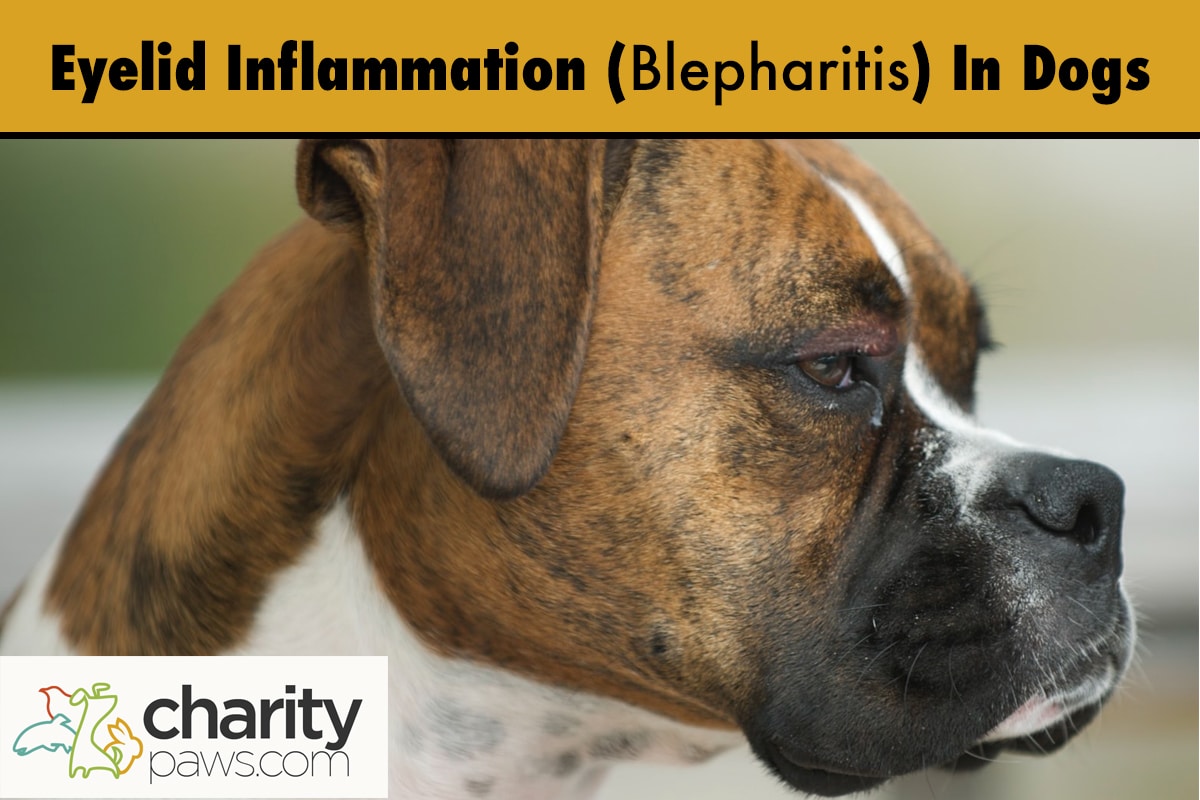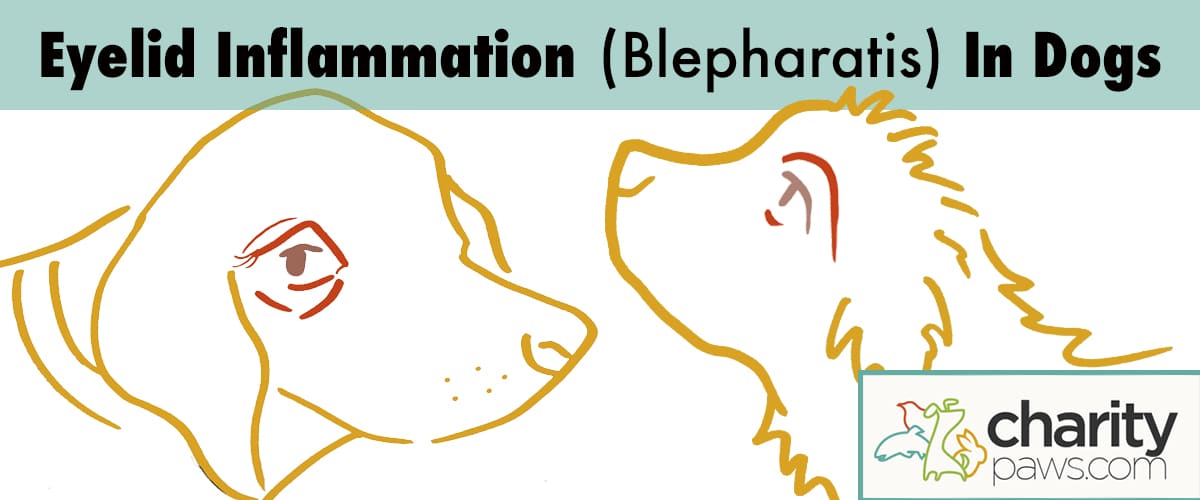Have you noticed that your dog’s eye is red and swollen?
If the skin and eyelids are looking puffy and sore, rather than the eyeball itself, then he could be suffering from a condition known as blepharitis.
It can be worrying to see your dog looking so uncomfortable and sorry for himself, so you probably want to know what you can do to help.
In this article, we look at blepharitis in more detail, including the various underlying causes and possible treatment options.
What Is Blepharitis In Dogs?

The eyelids are designed to protect the eye, produce secretions from small glands (know as meibomian glands) to keep the eye moist and blink regularly to distribute tears across the entire surface of the eye.
Blepharitis is the technical term for inflammation of the eyelids, which could affect the ability of the eyelids to perform their normal functions.
Often your dog will show signs of irritation, rubbing, and scratching at his face.
There could be inflammation of the actual eyeball as well, alongside increased discharge.
Symptoms of blepharitis include:
- Swollen eyelids
- Red or inflamed eyelids
- Increased discharge from the eyes
- Flaky or scaly skin around the eyes
- Hair loss near the eyes
- Increased itchiness of the eyes
- Increased blinking or squinting
- Issues with vision
What Causes Blepharitis In Dogs – 8 Main Reasons
There are a variety of different causes of blepharitis in dogs, so it’s important to take your pet to your veterinarian for a check over.
They will be able to help you work out what is going on and suggest an appropriate treatment.
Here is a list of just some of the possible causes of blepharitis in dogs:
Eyelid Injuries
Injury to the eyelids can lead to blepharitis.
This could include blunt trauma, like a knock to the eye, causing swelling and bruising, or could be something like a cut or graze.
Fighting is a common way of getting injured, usually between dogs or perhaps a cat scratch, and road traffic accidents are another potential cause of trauma.
Allergies
Animals can suffer allergic reactions, in the same way, that we do.
Just as with us, they can be allergic to an array of different things.
It could be a grass or tree pollen allergy or a reaction to an insect bite or sting.
Sometimes there is an obvious trigger but on other occasions, it can be hard to identify the cause.
Allergy testing can be helpful in some animals, whereas others have treatment trialed based on their examination and the history of their condition.
Bacterial Infections
Bacterial infections of the eyelids can occur, usually caused by Staphylococcus and Streptococcus species.
Eyelid inflammation occurs, as well as ulceration of the skin, hair loss, and problems with the tear-producing meibomian glands.
Antibiotic treatments are required as well as anti-inflammatories.
Foreign Bodies
Foreign bodies like thorns, splinters, or even bits of dust or sand, could become lodged in the soft tissues around your dog’s eye.
This could lead to soft tissue inflammation, pain, and discomfort.
The eyelids may become puffy if your dog excessively rubs at the area.
Tumors
Tumors of the eyelids can occur.
The most common type diagnosed are tumors of the meibomian glands, the small glands that help produce tears.
Most of these eyelid masses are benign, so won’t spread elsewhere in the body.
However, they can cause local irritation especially if they grow too large.
A chalazion is a different type of lump which can also occur in this location.
It is a non-cancerous, non-painful swelling of the meibomian gland, caused by a blockage and a build-up of secretions.
Other types of tumors can be more sinister, such as sebaceous adenocarcinomas, mast cell tumors, or melanomas.
There is a risk that these will spread and cause problems elsewhere in your dog’s body, as well as to the eye.
Diagnosis and treatment usually involve surgical removal of the mass, sending it away for analysis.
This is easier to do when masses are small in size, so do not hesitate in getting any eyelid lumps checked out as soon as possible by your vet.
Congenital Abnormalities
Some animals are born with abnormal eyelids, with some breeds being more prone to eye conditions than others.
Congenital issues are usually first detected in young animals, before a year of age.
An example of this is entropion, a condition where the eyelid is slightly turned in.
This inward rolling of the eyelid margin causes normal hairs to rub against the sensitive surface of the eye.
This leads to irritation, increased eye-watering, and even ulceration of the cornea.
Surgery is usually required to correct this condition.
Another problem that causes eye irritation is distichiasis, where abnormal hairs grow on the inside of the eyelid, scratching painfully against the eye surface.
Again, treatment is needed to correct this problem.
Autoimmune Condition
Keratoconjunctivitis sicca (KCS), otherwise known as ‘dry eye’, is a problem that affects tear production in dogs.
It is usually an autoimmune issue, but can sometimes be caused through other means too.
This condition is seen more frequently in dogs as they get older and leads to a thicker, more viscous, discharge in the eyes as well as secondary issues like irritation and ulceration of the eye.
Diagnosis can be made through a simple Schirmer Tear Test which uses small paper strips to measure tear production in your dog’s eyes.
Lubricants are needed to keep the eye moist, as well as medications aimed at counteracting the body’s immune reactions and providing anti-inflammatory action.
Pemphigus foliaceus is a rarer condition than dry eye but is sometimes a cause of eyelid problems in dogs.
It is again caused by the dog’s immune system attacking its own body, but in this case, causing problems with a normal part of the skin’s layers.
This leads to sore, inflamed areas, not only affecting the skin on the eyelids but elsewhere on the body too.
The diagnosis is usually made by taking biopsies, with samples of skin tissue being sent to the lab for analysis.
Treatment requires extended courses of immunosuppressive medications.
Parasitic Infections
Mites can cause skin problems, leading to inflammation and itchiness.
There is the potential for mange mites like Demodex spp and Sarcoptes spp to invade the skin around the eyes as well as elsewhere on the body.
Dog Breeds That Are Susceptible To Eye Inflammation
While many of the conditions that cause eyelid inflammation can affect all dogs, some breeds are more prone to eye problems than others.
The most affected breeds tend to be the brachycephalic dogs, with short noses and flattened faces.
These dogs tend to have an excess of wrinkly skin as well as proportionally large and prominent eyes, often suffering from entropion.
There are however other dogs with normal noses that are also prone to eye issues.
The following is a list of breeds that may be more likely to develop these eye issues:
- English bulldogs
- French bulldogs
- Pugs
- Pekingese
- Lhasa apso
- Golden retrievers
- Rottweilers
- Poodles
- Labrador retrievers
How Is Blepharitis Diagnosed?
Your veterinarian will start by doing a physical examining your dog as well as discussing with you the symptoms your dog is showing and anything that could have triggered the condition.
Depending on their examination they may need to suggest some further tests.
A more thorough eye exam might be needed next, using an instrument called an ophthalmoscope to help magnify parts of the eye as your vet looks at them.
A special dye may be applied to the surface of the eye to highlight any scratches or ulcers on the surface (cornea) and a Schirmer tear test could be performed to screen for autoimmune conditions like ‘dry eye’ (keratoconjunctivitis sicca).
Biopsies may be recommended, to take samples from the affected area for examination at the lab.
Many types of cancer, inflammatory or autoimmune conditions can be diagnosed in this way.
If allergies are suspected then allergy testing could be recommended to try and work out what your dog’s triggers are.
Sometimes more information is required about your dog’s health status so blood tests could be advised for biochemistry and hematology, as well as analysis of your dog’s urine.
This may help to give clues about any underlying generalized disease, particularly if other tests haven’t yet identified a cause.
Your veterinarian will talk you through the recommended diagnostics for your pet.
Treatment Options For Blepharitis
The treatment for blepharitis varies greatly, depending on what the underlying cause is.
This is why it is important that your vet examines your dog and performs diagnostics, to ensure the right treatment is prescribed.
For autoimmune conditions, immunosuppressive medications like steroids or cyclosporin are required.
In cases of bacterial infection, antibiotic eye drops, and lubricants may be needed, whereas, with congenital issues and eyelid tumors, surgery is often the treatment of choice.
Your vet will be able to guide you through the treatment options available for your pet’s condition.
Can You Prevent Blepharitis In Dogs?

In many cases, no, you may not be able to prevent blepharitis from occurring.
There are some steps you can take to try and keep your pet’s eyes and skin as healthy as you possibly can though.
When adopting or rescuing a dog try and choose a breed that is not prone to eye issues, or at least, buy a puppy that has been bred from adult dogs that have healthy eyes.
Many pedigree breeds have recommended eye checks that should be performed before mating, to increase the chances of producing healthy offspring.
Make sure your pet is on a good quality diet, is kept up to date with their vaccinations, and has regular check-ups.
If your dog has been diagnosed with allergies then try and avoid his triggers.
Make sure your dog has his allergy medication regularly if he’s been prescribed it, don’t skip doses.
Above all, seek attention early if you think your dog has an issue with their eyes or eyelids as treatment is more likely to be effective when started promptly.
Conclusion
Blepharitis (eyelid inflammation) can be caused by several different conditions, so it is important to get your dog checked over by your vet as soon as possible.
Diagnostic tests and treatments may vary depending on your dog’s symptoms, but your vet will discuss this with you.
By acting quickly, you can prevent any further damage to your dog’s eyes and soon get him feeling comfortable again.
FAQs
What to do if the skin around my dog’s eye is red and swollen?
You should contact your veterinarian if your dog is suffering from inflammation of the eyelids (blepharitis) or nearby skin.
There are so many causes for this, that you will need to seek professional help to work out what the best treatment options might be.
The quicker you seek help; the more successful treatment will be.
How do you treat a swollen eye on a dog?
Treatment will depend on the underlying cause of your dog’s swollen eye.
It could involve antibiotics, anti-inflammatories, immunosuppressives, or even surgery.
Your vet will advise you on the best course of action for your pet and their circumstances.

